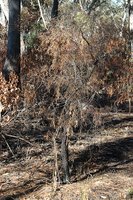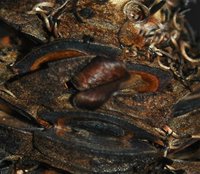This is regarded as an evolutionary issue, in that many of the plants with good fire survival strategies are "modern" plants which are understood to have evolved as Australia drifted further north, and progressively dried out, to become the fire-ravaged "sunburnt country" which it is today.
*****
I mentioned yesterday that the Eucalypts survived these cold burns, with little or no damage. That is due to their thick bark. But we all are familiar with the fact that even after a devastating fire, most Eucalypts can re-shoot from dormant buds hidden under their bark. So, even though the leaves get totally burnt, the stem is scorched, but not killed (usually). Within weeks of a fire, new shoots appear all over the plant. After a few years, the plant settles down to normal growth.
Acacias have very hard seeds which fall as their seed capsules ripen, every year. But the seeds can remain viable on the forest floor for years. After a fire, these seeds will germinate, as the hard coating on the seed will have been cracked by the heat of the fire, allowing the seed inside the coating to absorb water, and start to grow.
Some plants have thick bark on their trunks, which protect the living tissue of the plant from the heat of the fire, and, although the leaves may be burnt, they can regenerate quickly, after a fire. Surprisingly, the Rough Tree Fern, Cyathea australis, is such a plant. It is rainforest plant, primarily, yet it has a good fire survival strategy. That is an unusual combination, as many rainforest plants are notoriously weak at surviving fire.
Indeed that point is the flip side of my opening comments on modern plants having evolved to suit Australia's increasingly dry climate. That adaptation involved surviving fire. Many of the local rainforest plants are of ancient lineage, having evolved when Australia had a wetter, colder climate than it does today. That is why they are plants which tend to grow in remnant pockets of rainforest, in wet patches (such as Robertson), which is not very susceptible to bush fires.
*****
Within the Eucalypt forests of which I was talking yesterday, the most obvious fire survival strategies are: flaky bark, to protect the trunk; suckering from a root stock protected under the soil and storage of seeds, which open after the fire has passed.
Persoonia linearis - flaky bark.

Several of the local Persoonias (Geebungs), Persoonia linearis and P. levis, both have thick flaky bark, which gets singed in a fire, but which protects the living layer of tissue in the trunk (the cambium).
Persoonia linearis - singed by fire.

This shrub has been singed by fire, but it will probably re-shoot successfully, because of its protective bark. The leaves will have been killed, but new growth will occur.
Persoonia linearis produces lots of fleshy fruit.
 These plants also produce an excess of fruit, which are often seen lying all over the ground, under the shrub.
These plants also produce an excess of fruit, which are often seen lying all over the ground, under the shrub.Persoonia seeds are notoriously hard to germinate in cultivation, but seedlings are commonly found in the bush. One explanation is that birds and animals eat the seeds, and in so doing "treat" the seeds in their digestive systems, in a way that favours germination.
However, there are also reports that some species of Persoonia are found to have good germination after fire. So, presumably some of these seeds, (which appear to have a very long germination period), might remain viable in the soil, and then germinate, in post-fire conditions.
Waratahs, Lomatias and at least one of the local Persoonias (P. laurina) all are obviously suckerers. A quick walk through this forest will show you that. Look at your local Waratah - if there is one plant growing, there will often be a series of smaller plants close by. Often you will find a taller dead plant (burnt) with regenerating plants around it, in a circle. The Lomatias and the little Persoonia are less obvious plants, but their strategy is the same.
 Then there are the Banksias and Hakeas. These plants have a sacrifical strategy when it comes to fire. The adult plants have little or no resistance to fire, and simply die when a fire occurs.
Then there are the Banksias and Hakeas. These plants have a sacrifical strategy when it comes to fire. The adult plants have little or no resistance to fire, and simply die when a fire occurs.But they have woody capsules in which their seeds remain viable for many, many years. Then, when the fire is raging, the seeds are protected inside these hard woody capsules. But within days of the fire passing, the old woody capsules slowly open (like oysters), and the seeds fall out, onto the ash layer on top of the soil. That ash contains chemicals from the burnt wood which has been found to promote germination of these seeds. Indeed, many native plant nurseries use "smoke treatment" for the same reason, to greatly promote the germination of native plant seedlings.
 Old Native Plant books used recommend growers heat treat seed capsules of Hakeas and Banksias, in order to get the capsules to open and release their seeds. The usual method recommended was to put them in the oven, after someone had been cooking, and the oven was cooling down. That technique misses out on the "smoke" effect, but one can buy "smoke water" to soak seeds in, from many native plant specialists.
Old Native Plant books used recommend growers heat treat seed capsules of Hakeas and Banksias, in order to get the capsules to open and release their seeds. The usual method recommended was to put them in the oven, after someone had been cooking, and the oven was cooling down. That technique misses out on the "smoke" effect, but one can buy "smoke water" to soak seeds in, from many native plant specialists.Pairs of curved seeds may be seen emerging from some of these woody capsules on the burnt seed cone of Banksia cunninghamiana.
These Banksia cones might be regarded as "time capsules", holding the seeds in virtual suspended animation, waiting for a fire to come and open the capsules with its heat, before the seeds can be safely released. In a few months time, there will be lots of young seedling growing near where the old plant died. That is why I refer to it as a "sacrificial strategy" - even though fire kills the main plant, the species will go on.
*****
I mentioned yesterday, how dangerous it is if fires occur too often.
Some species, such as the Banksias, and Acacias, rely on seed in order to survive a fire, as the plant itself is killed by fire. So, in order for the species to survive, it needs to have set seed.
Many plants take a number of years to reach maturity. They need to have reached flowering age, been pollinated, and then to have set seed, before they are able to survive a second fire. So, if, for example, this area was burnt off now, and then, in 3, 4 or 5 years, it was re-burnt, it is entirely possible that Banksias would be eliminated from that patch of forest. For some plants, this maturity cycle might be as long as 8 years.
So, repeated burning, as a forest management strategy can result in producing a "forest" with a live canopy of Eucalypts, but little of no understorey of shrubbery. That is not a real forest - it is a "treed desert" - with few species of plants, and even fewer birds and animals.
Unless the people who set fires like these ones, understand that, they risk permanently damaging the living forest, if they burn it too often.
Indeed, even if they do understand it, who is to say that any subsequent fire might not be a major bush fire which might occur naturally, in circumstances totally beyond the control of humans? If such a devastating fire occurs within that 8 year time period, the damage can be permanent.
Even if the subsequent fire is not lit by people, but is entirely natural, the result is the same.

No comments:
Post a Comment